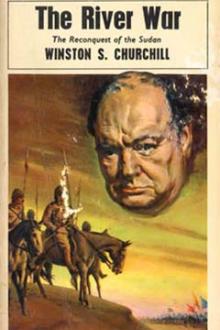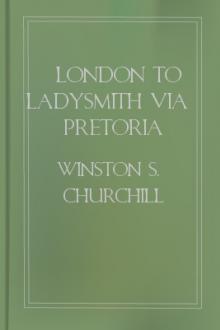The River War - Winston Churchill (books under 200 pages .txt) 📗

- Author: Winston Churchill
- Performer: -
Book online «The River War - Winston Churchill (books under 200 pages .txt) 📗». Author Winston Churchill
An inhuman butchery of the children and some of the women followed.
Abdalla-Wad-Saad was among the killed.
A few of the Jaalin who had escaped from the general destruction fled towards Gakdul. Here they found the Camel Corps with their caravan of rifles and ammunition. Like another force that had advanced by this very road to carry succour to men in desperate distress, the relief had arrived too late. The remnants of the Jaalin were left in occupation of Gakdul Wells. The convoy and its escort returned to Korti.
But while the attention of the Khalifa was directed to these matters, a far more serious menace offered from another quarter. Unnoticed by the Dervishes, or, if noticed, unappreciated, the railway was stretching farther and farther into the desert. By the middle of July it had reached the 130th mile, and, as is related in the last chapter, work had to be suspended until Abu Hamed was in the hands of the Egyptian forces.
The Nile was rising fast. Very soon steamers would be able to pass the Fourth Cataract. It should have been evident that the next movement in the advance of the ‘Turks’ impended. The Khalifa seems, indeed, to have understood that the rise of the river increased his peril, for throughout July he continued to send orders to the Emir in Berber—Yunes—that he should advance into the Monassir district, harry such villages as existed, and obstruct the frequent reconnaissances from Merawi. Yunes, however, preferred to do otherwise, and remained on the left bank opposite Berber until, at length, his master recalled him to Omdurman to explain his conduct. Meanwhile, determined with mathematical exactness by the rise of the Nile and progress of the railway, the moment of the Egyptian advance arrived.
At the end of July preparations were made, as secretly as possible, to despatch a flying column against Abu Hamed. The Dervish garrison, under Mohammed-ez-Zein, was not believed to exceed 600 men, but in order that there should be no doubt as to the result it was determined to employ a strong force.
A brigade of all arms was formed as follows:-
Commanding: MAJOR-GENERAL HUNTER
Cavalry … … . One troop Artillery … … No. 2 Field Battery [This battery consisted of six Krupp guns, two Maxims, one Gardner gun, and one Nordenfeldt—an effective medley.]
Infantry … … . MACDONALD’S BRIGADE
- 3rd Egyptian - IXth Soudanese - Xth “
- XIth “
Major-General Sir Archibald Hunter, the officer to whom the operation was entrusted, was from many points of view the most imposing figure in the Egyptian army. He had served through the Nile Expedition of 1884-85, with some distinction, in the Khedive’s service. Thenceforward his rise was rapid, even for an Egyptian officer, and in ten years he passed through all the grades from Captain to Major-General. His promotion was not, however, undeserved. Foremost in every action, twice wounded—once at the head of his brigade—always distinguished for valour and conduct, Hunter won the admiration of his comrades and superiors. During the River War he became, in spite of his hard severity, the darling of the Egyptian Army.
All the personal popularity which great success might have brought to the Sirdar focussed itself on his daring, good-humoured subordinate, and it was to Hunter that the soldiers looked whenever there was fighting to be done. The force now placed under his command for the attack upon Abu Hamed amounted to about 3,600 men. Until that place was taken all other operations were delayed. The Sirdar awaited the issue at Merawi.
The railway paused in mid-desert.
The troops composing the ‘flying column’ concentrated at Kassingar, a small village a few miles above Merawi, on the right (or Abu Hamed) bank of the Nile. General Hunter began his march on the 29th of July. The total distance from Kassingar to Abu Hamed is 146 miles. The greatest secrecy had been observed in the preparation of the force, but it was known that as soon as the column actually started the news would be carried to the enemy. Speed was therefore essential; for if the Dervish garrison in Abu Hamed were reinforced from Berber, the flying column might not be strong enough to take the village. On the other hand, the great heat and the certainty that the troops would have to fight an action at the end of the march imposed opposite considerations on the commander. To avoid the sun, the greater part of the distance was covered at night. Yet the advantage thus gained was to some extent neutralised by the difficulty of marching over such broken ground in the darkness.
Throughout the whole length of the course of the Nile there is no more miserable wilderness than the Monassir Desert. The stream of the river is broken and its channel obstructed by a great confusion of boulders, between and among which the water rushes in dangerous cataracts. The sandy waste approaches the very brim, and only a few palm-trees, or here and there a squalid mud hamlet, reveal the existence of life. The line of advance lay along the river; but no road relieved the labour of the march. Sometimes trailing across a broad stretch of white sand, in which the soldiers sank to their ankles, and which filled their boots with a rasping grit; sometimes winding over a pass or through a gorge of sharp-cut rocks, which, even in the moonlight, felt hot with the heat of the previous day—always in a long, jerky, and interrupted procession of men and camels, often in single file—the column toiled painfully like the serpent to whom it was said, ‘On thy belly shalt thou go, and dust shalt thou eat.’
The column started at 5.30 in the evening, and by a march of sixteen and a half miles reached Mushra-el-Obiad at about midnight. Here a convenient watering-place, not commanded by the opposite bank, and the shade of eight or ten thorny bushes afforded the first suitable bivouac. At 3.30 P.M. on the 30th the march was continued eight and a half miles to a spot some little distance beyond Shebabit. The pace was slow, and the route stony and difficult. It was after dark when the halting-place was reached.
Several of the men strayed from the column, wandered in the gloom, and reached the bivouac exhausted. General Hunter had proposed to push on the next day to Hosh-el-Geref, but the fatigues of his troops in the two night marches had already been severe, and as, after Abu Haraz, the track twisted away from the river so that there was no water for five miles, he resolved to halt for the day and rest. Hosh-el-Geref was therefore not reached until the 1st of August—a day later than had been expected; but the rest had proved of such benefit to the troops that the subsequent acceleration of progress fully compensated for the delay. The column moved on again at midnight and halted at daybreak at Salmi. In the small hours of the next morning the march was resumed. The road by the Nile was found too difficult for the Maxim guns, which were on wheels, and these had to make a detour of twenty-eight miles into the desert while the infantry moved ten miles along the river. In order that the Maxims should not arrive alone at Dakfilli, General Hunter had marched thither with the IXth Soudanese at 11 P.M. on the previous day. The rest of the column followed a few hours later. On the 4th, by an eighteen-mile march through deep sand, El Kab was reached. A single shot was fired from the opposite bank of the river as the cavalry patrol entered the village; and there was no longer any doubt that the Dervishes knew of the advance of the column. Both the troops and the transport were now moving admirably; nevertheless, their sufferings were severe.
The nights were consumed in movement. Without shade the soldiers could not sleep by day. All ranks wearied, and the men would frequently, during the night marches, sink down upon the ground in profound slumber, only to be sternly aroused and hurried on. But the pace of the advance continued to be swift. On the 5th, the force, by a fourteen-mile march, reached Khula.
Here they were joined by Sheikh Abdel-Azim with 150 Ababda camelmen from Murat Wells. Up to this point three Egyptians had died and fifty-eight men had been left behind exhausted in depots. A double ration of meat was issued to the whole force. The column moved on during the night, and arrived at Ginnifab at 8 A.M. on the morning of the 6th. Here startling news of the enemy was received. It was known that Mohammed-ez-Zein was determined to fight, and a trustworthy report was now received that a large force was coming down from Berber to support the Abu Hamed garrison.
In spite of the long marches and the fatigues of the troops, General Hunter resolved to hurry on. He had already made up the day spent at Abu Haraz.
He now decided to improve on the prescribed itinerary, accelerate his own arrival and anticipate that of the Dervish reinforcements. Accordingly the troops marched all through the night of the 6-7th with only a short halt of an hour and a half, so as to attack Abu Hamed at dawn. After covering sixteen miles of bad ground, the ‘flying column’ reached Ginnifab, 144 miles from Kassingar and only two from the Dervish post, at 3.30 on the morning of the 7th of August. A halt of two hours was allowed for the troops to prepare themselves. Half the 3rd Egyptian Battalion remained as escort to the transport and reserve ammunition, and then the force moved off in the darkness towards the enemy’s position.
The village of Abu Hamed straggles along the bank of the Nile, and consists of a central mass of mud houses, intersected by a network of winding lanes and alleys, about 500 yards long by perhaps 100 yards wide.
To the north and south are detached clusters of ruined huts, and to the south there rises a large, ragged pile of rocks. The ground slopes gradually up from the river, so that at a distance of 300 yards the village is surrounded on three sides by a low plateau. Upon this plateau stand three stone watch-towers, which were erected by General Gordon. The Dervish garrison were strongly posted in shelter trenches and loopholed houses along the eastern face of the village. The towers were held by their outposts.
Making a wide circuit to their left, and then swinging round to the right, so as to front facing the river, the brigade silently moved towards the enemy’s position, and at a quarter past six occupied the plateau in a crescent-shaped formation; the XIth Soudanese on the right, opposite the northeast corner of the village; the battery, escorted by the remaining half-battalion of the 3rd Egyptians, next; then the IXth in the centre, and the Xth Soudanese on the left flank. As the troops approached the watch-towers the Dervish outposts fell back and the force continued to advance until the edge of the plateau was reached. From here the whole scene was visible.
The day was just breaking, and the mist hung low and white over the steel-grey surface of the river. The outlines of the mud houses were sharply defined on this pale background. The Dervish riflemen crouched in the shelter trench that ran round the village. Their cavalry, perhaps a hundred strong, were falling in hurriedly on the sandy ground to the south near the





Comments (0)